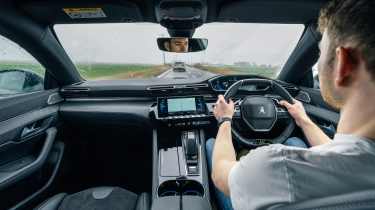Peugeot 508 – interior and tech
A riot of design and technology, and while ergonomics won't be for some, standards of build, comfort and tech are all high
The 508’s interior will be a shock to the system, at least if you’re unfamiliar with Peugeot’s previous interior design trends. Climb in - through doors with frameless windows, like an Audi A7 - and you’re faced with a small, almost hexagonal steering wheel, a large digital instrument display, raised centre console, and plenty of eye-catching details.
Some will instantly hate it. Like other Peugeots using the firm’s 'i-Cockpit' layout - basically, a small, low-mounted steering wheel and high-set instruments - there will be a certain range of body shapes who just won’t be able to find a driving position that’s both comfortable and gives full view of the instruments.
Others will be fine, and it’s fair to say that with time to adapt it’s easy to settle into a suitable position - the trick is usually as simple as positioning the wheel slightly lower than normal, aware that its smaller size means it won’t foul the tops of your legs as a normal-sized wheel might.
> Mercedes C-class review – BMW 3-series rival strikes back
Once you do find the right driving position, there’s a lot to like. The seats are comfortable, the cabin is hushed, and Peugeot’s implementation of physical hot-keys for the central display means choosing between menus is simpler than it used to be - and that bank of keys acts as a shelf to steady your hand when using the screen, too. The digital instruments have various layouts, only a few of which are truly useful, but you do get sat nav information and other key data presented ahead of you in a clear format.
Above all, it’s just an imaginatively-designed environment, and one that feels considerably more special than most others in the class. Peugeot even seems to be getting build quality right these days - we’ve found no obvious concerns with quality so far.
508s pack some advanced technology. There’s that TFT display screen for a start, as well as typically-found features like adaptive cruise control, lane-keep assist (best switched off, in our experience), speed limit recognition, and high beam assist. More impressively, it’s the first car in the segment with night vision, and it genuinely works - on one night-time drive, it alerted us to a pedestrian unwisely walking down the side of the road rather than on the pavement that hadn’t been illuminated by the headlights.


